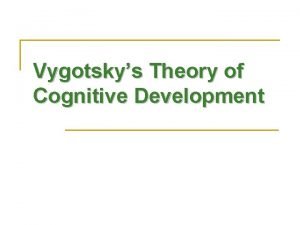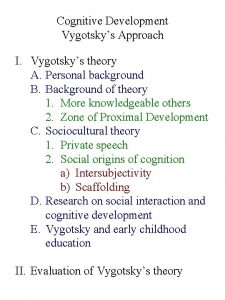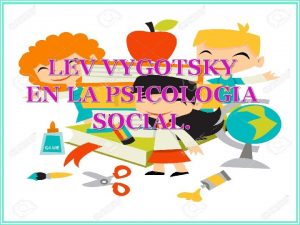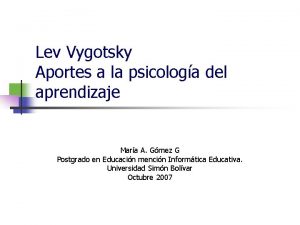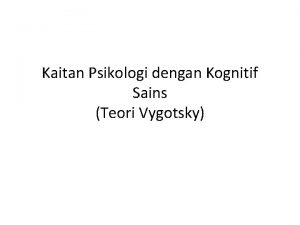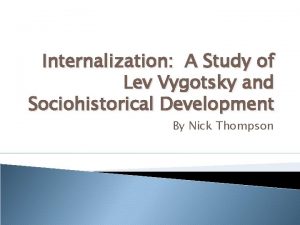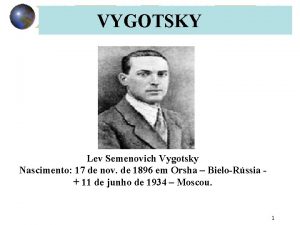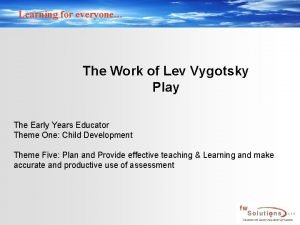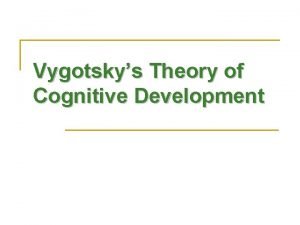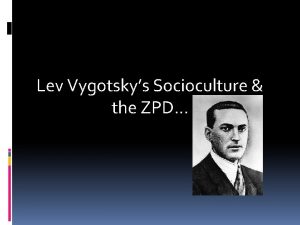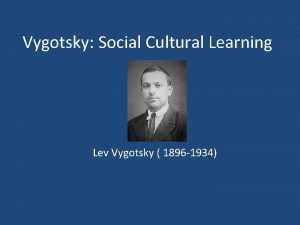VYGOTSKYS THEORIES OF LEARNING Ms Carmelitano Lev Vygotsky










- Slides: 10

VYGOTSKY’S THEORIES OF LEARNING Ms. Carmelitano

Lev Vygotsky Russian psychologist � Studied how children play, socialize, and develop language in the context of understanding their world Developed a “sociocultural approach” to cognitive development � He describes the process by which children acquire knowledge by taking into account the child’s social environment and culture � He argues that culture provides knowledge, and teaches children what to think and how to think (Remember Cole and Scribner? )

Vygotsky’s Learning Theory A child’s cognitive development is based on the interaction with other people, as well as the cultural tools to understand the world which are provided by the child’s culture. � (Cultural Schemas/ Cultural norms) � As well as physical tools provided by the culture Knowledge is transferred via imitation, instructions, and collaborative learning � Language is the primary form of interaction that adults use to teacher the child the knowledge that exists in the culture � As the child grows, language comes to serve as the most important learning tool

Theory Divided the intellect into basic innate capabilities – elementary function (attention and sensation) and higher mental functions Argued that elementary functions can only develop into higher level functions via the input of culture Vygotsky thought of culture as a body of knowledge held by people of greater knowledge or in books – transmitted through language – therefore he placed a large importance on language development as part of overall cognitive development Cultural knowledge is the means by which cognitive development takes place

Language Language is the primary way we produce change in others When it is internalized, it converges with thought, and we are able to direct and control our thinking with the use of language We develop and inner voice for thinking and a more complex, vocabulary-rich voice for communication with others

Language Progresses in three stages � Pre-intellectual social speech (0 -3 years old) – Thought is not constructed using language and speech is only used to enact social change � Egocentric speech (3 -7 years old) – Language helps to control the child's own behavior and is spoken out loud � Inner speech (7 _ years old) – The child uses speech silently to develop their thinking and publically for social communications

The Zone of Proximal Development This theory refers to the difference between what a child can do on their own and what they can accomplish with help Scaffolding: � If the child receives help, they can increase their competency level to perform a task just slightly above their natural ability level � This assistance will help the child advance in their cognitive development

Compared to Piaget Agrees with Piaget � Children actively construct knowledge and that they learn best if new knowledge is related to existing knowledge and abilities (assimilation) Different from Piaget Vygotsky believed the child makes sense of the world through shared meaning with others � Piaget believed the child makes sense of the world as a result on an innate maturation process that drives cognitive development � Vygotsky believed that most of what children learn comes from their culture � Because of this Vygotsky suggests cooperative learning instead of child-centered learning (Piaget)

Evaluation of Vygotsky Conner et al (1997) Argued the quality of scaffolding provided by a mother and father could predict the success of the child in the classroom He applied this theory to reading and math exposure during early development � Children who were supported at home were more confident in the classroom � He argued the inner voice was a key part of learning and cognitive development � Behrend et al (1992): quantified inner speech by observing the amount of whispering and lip movement children engaged in when given a task � Found children who used the greatest amount of inner speech preformed better on tasks

Evaluation - Criticisms Some say Vygotsky places too much emphasis on the social environment and is too vague in his outline of social influence He also lacked much empirical support � However he died at age 37 of Tuberculous, so he may not have fully developed his theories
